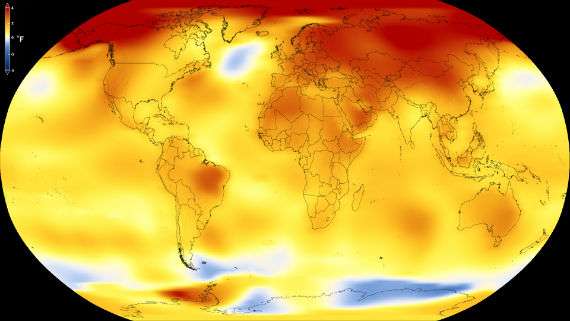2017 Was the Second Hottest Year Since 1880, Says NASA
It was the 41st consecutive year with global temperatures above the 20th-century average.

2017 was the second-warmest year since 1880, according to NASA. Only 2016 was warmer.
More specifically, NASA reports that globally averaged temperatures last year were 0.90° Celsius warmer than the mean temperature from 1951 to 1980. The three other major institutions that track global temperature trends find that 2017 is the third warmest year in their records.
The National Oceanic and Atmospheric Administration reports:
The average temperature across the globe in 2017 was 1.51 degrees Fahrenheit (0.84 degrees Celsius) above the 20th century average of 57 degrees Fahrenheit (13.9 degrees Celsius). 2017 marks the 41st consecutive year (since 1977) with global land and ocean temperatures at least nominally above the 20th-century average.
"The six warmest years on record for the planet," the agency adds, "have all occurred since 2010."
Researchers at the Met Office Hadley Centre and the University of East Anglia's Climatic Research Unit report that the global average temperature in 2017 was about 0.99° Celsius above pre-industrial levels, and about 0.38° Celsius above the 1981–2010 average.
The climatologists at the University of Alabama in Huntsville who oversee the satellite temperature data report that the average temperature in the lower troposphere over the globe in 2017 was 0.375° Celsius warmer than seasonal norms. These temperature trends are calculated relative to a 30-year average (1981–2010). The Huntsville satellite record trend, often cited by folks who are less concerned about climate model projections, is basically identical to the Hadley Centre's conclusions.

Remote Sensing Systems (RSS) also uses satellite temperature data to calculate global temperature trends. It reports that 2017
was the second warmest recorded since satellite observations began in 1979. Last year, 2016, was the warmest ever recorded. The near-record warmth of 2017 is notable because an El Niño event did not occur in 2017. The other 3 warmest years, 1998, 2010, and 2016, were El Niño years. Except for 1998, all of the warmest years occur after 2000, providing clear evidence of global temperature increase in the troposphere.
RSS notes that the although the recent warm years have brought climate model projections and measured temperature trends closer, it is still the case the "the troposphere has not warmed quite as fast as most climate models predict."
The Huntsville researchers find that the globe is warming at 0.13° Celsius per decade, while RSS reports a warming trend of 0.18° Celsius per decade. The surface data trends fall within this range. It is generally agreed that the earth has warmed by about 1° Celsius since the 19th century.
If the Huntsville rate of temperature increase is maintained for the rest of this century, the world would end up just a bit over 2° Celsius warmer than it was around 1900. If the RSS trend is sustained, that would yield a further increase of nearly 1.5° Celsius, resulting in a global average temperature that's 2.5° Celsius warmer than it was in 1900. It is worth noting that the temperature difference between now and the last ice age is between 4 to 7° Celsius. That increase occurred at a much slower pace.
